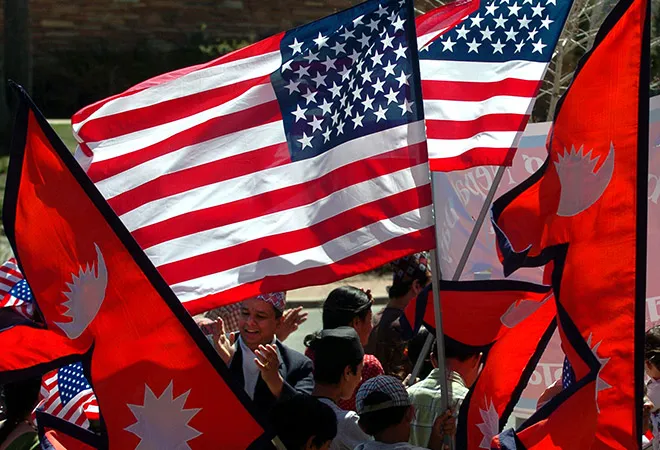
The inception of the bilateral diplomatic relationship between the US and the small land-locked Himalayan country of Nepal was in 1947. Through the years, subsequent bilateral ties have been cordial. Since the first bilateral donor-agreement in 1951, more than US$ 1.6 billion worth assistance has been provided to Nepal for developmental purposes — primarily focusing on education, elimination of extreme poverty, building resilience, increasing human capital. Relatively recent additions to the list include the US economic help for the post-earthquake reconstruction and the maintenance of inclusive democracy in Nepal. In this regard, special mention must be made of the United States Agency for International Development (USAID) that has been assisting Nepal in reinforcing and fortifying security and economic prosperity.
The US indeed understands the vitality of the congenial geopolitical location of Nepal as an important ‘buffer’ in South Asia, strategically placed between India and China. The country also understands that in order to maintain its presence in the region, the role of the landlocked countries can be equally important, as they hold within themselves the potential of either making or breaking the game.
The US indeed understands the vitality of the congenial geopolitical location of Nepal as an important ‘buffer’ in South Asia.
During the past few years, issues like the Indo-Nepal blockade of 2015, the political map conundrum of 2019 are all incidents that have inadvertently pushed Nepal into the arms of China, much to the dismay of both India and the US. Though no specific strategy has been observed during the four-year-term of the outgoing US President, Donald Trump’s administration towards Nepal, many controversies had resurfaced, requiring early resolution.
With a win-win situation on the China front, and India trying its best to play along, Nepal is now waiting to see how the US handles bilateral relations, particularly in the context of Washington’s Indo-Pacific strategy and the like. While Nepal will undoubtedly enjoy the fruits of benefit, it must acknowledge the importance of making it a stepping-stone for creating a niche for itself in global politics and not end up feeling upset over a ‘missed opportunity.’
Nepal is now waiting to see how the US handles bilateral relations, particularly in the context of Washington’s Indo-Pacific strategy and the like.
Country’s compulsions
Just like the rest of the world, Nepal also had been keeping a keen eye on the recently-held US presidential elections. Nepalese President Bidya Devi Bhandari and Prime Minister K.P. Sharma Oli were among the first few world leaders to congratulate the US President-elect, probably with the hope of refurbishing the several controversial aspects of the bilateral tie.
Ranging from issues like the Millennium Challenge Corporation (MCC) Compact and the participation of Nepal in the Indo-Pacific to the relationship that Nepal shares with China, an inadvertent hope is obvious on part of Nepal — the country that has not been able to garner positive attention in the past. Therefore, the situation now seems to be ripe to reorient the relationship by instilling new foreign policy mechanisms that can be helpful for not only the US and Nepal but the whole of South Asia, which is undoubtedly one of the most dynamic regions of the world in recent times.
The US must understand that using Nepal as a buffer in the Indo-Pacific against China would not be an easy task.
Given the proximity that Nepal shares with China, one of the foremost tasks of a Biden administration should be to establish a comprehensive action-oriented framework that would be as constructive as the Belt and Road Initiative (BRI) of China. Rather than outrightly projecting China as a ‘revisionist power’ in state doctrines, the US must understand that using Nepal as a buffer in the Indo-Pacific against China would not be an easy task.
Washington must not forget that Nepal was overtly dissatisfied with its mention in the Indo-Pacific strategy doctrine of the US, reiterating a position of non-alignment. This has been a very controversial and sensitive issue for the country which does not want to be a part of any military alliance as such.
Though economic alliance does not necessarily denote military alliance, the scepticism prevails.
Similar connotations are also applicable to the MCC Compact as well. Nepal has been always skeptical about the ratification of this compact because of the direct link it has with the Indo-Pacific doctrine. The MCC has been allegedly being promoted as a part of the Indo-Pacific Strategic Report of the US, as mentioned by David J. Ranz, the Assistant Secretary for South Asia at the US State Department.
Though economic alliance does not necessarily denote military alliance, the scepticism prevails. If Nepal becomes an active participant in the Indo-Pacific, within a strategic nexus led by the US, it would send a wrong signal to both India and China regarding its ambitions, which the country at this moment cannot afford.
Prime Minister Sharma Oli has been quite keen to sign the Millennium Challenge Corporation Compact.
Moreover, the compact also states that it would prevail over Nepal’s existing laws in the case of conflicts that have furthermore created a sense of negativity towards it despite the aid it provides. However, the fact remains, Prime Minister K.P. Sharma Oli has been quite keen to sign the compact and get it ratified by Parliament which is reflective of Nepal becoming a part of the MCC for sure in the long-run. Foreign Minister Pradeep Kumar Gyawali has even negated the Indo-Pacific confusion despite what officers have come and said.
Middle-income status
The US must treat Nepal as an entity by itself. It has been clearly mentioned in the USAID documents that the US is committed to help Nepal achieve middle-income status by 2030. As Nepal has a more or less slow growing economy along with a history of earthquake (2015) and a decade long insurgency that ended in 2006, US can prove to be a partner leading the country towards self-reliance. From disaster risk reduction to reconstruction, food security, management of natural resources, healthcare and making connectivity opportunities more viable, it is important for Nepal to not let go off the opportunity in this new Biden administration, which is yet to conform to new set of foreign policy directives towards South Asia.
The better idea would be to help create a balance between the extended and immediate neighbourhood.
However, Nepal must be very clear that this association is majorly from the economic forefront and has nothing to do with any traditional security association that might jeopardise its relationship with its immediate neighbours. As the country has to survive within this particular region with the usage of aid and facilities from its surrounding as well, the better idea would be to help create a balance between the extended and immediate neighbourhood.
Also, Nepal must have one foot forward towards the Indo-Pacific region as well because that is the most dynamic theme in International relations today. The only point to be considered is the idea of being slow and steady that can only come from financial stability and better connectivity.
This essay originally appeared in South Asia Weekly.
The views expressed above belong to the author(s). ORF research and analyses now available on Telegram! Click here to access our curated content — blogs, longforms and interviews.




 PREV
PREV


